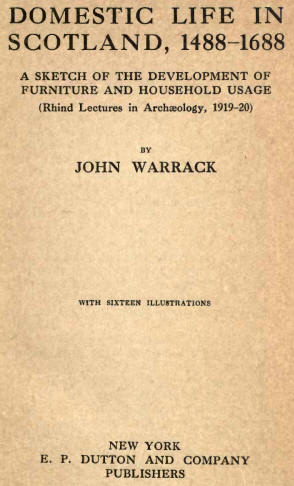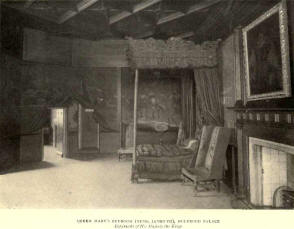

Preface
FEW realise how modern are
the conceptions of comfort and decency which inspire the furnishing and
arrangements of our present-day homes, or how different were the conditions
in which, only a few centuries ago, our forefathers spent their lives. Till
the beginning of the seventeenth century chairs for ordinary household use
were unknown. Hats were worn at meals. Washing formed no part of the morning
toilet, even in Charles II's time, and very few in any country in Europe
washed their faces every day. The use of forks did not become general till
the eighteenth century, and food was picked from the general dish and raised
to the mouth with the fingers.
The development of Domestic
Life has not, I think, hitherto been studied as a continuous process, nor
traced to its social and historical origins, though many of its details have
been worked out and much knowledge of a fragmentary kind has been
accumulated. In trying to reconstruct the domestic life of Scotland at
various epochs in the fifteenth, sixteenth and seventeenth centuries, and to
trace the lines of development, I have had recourse to the comparison and
analysis of many hundreds of early inventories which are to be found among
the national documents preserved in the Register House, and the study of
these records has resulted in much new and curious information as to the
details of household life in early times. I have also drawn freely on early
Scottish literature, including biographies, journals and account books, for
material likely to put my readers into more living touch with the men, women
and children of the times with which I have dealt.
While the book deals mainly
with Scotland, there are many references to the social develop- ment of
England, France and other countries in western Europe. For a general enquiry
there is a certain advantage in the smaller and less crowded stage. To the
non-Scottish reader I would address the invitation and guarantee given by a
character in a witty French comedy:—
Mon camarade
Allons faire au jardin un tour de promenade!
Suivez-moi sans rien craindre; it est dans mes principes
De ne forcer personne a louer nos tulipes!
To express in detail all my
obligations to those who have helped me would overweight my book. But I must
acknowledge the kindness of Sir James Balfour Paul, C.V.O., in reading my
proofs; of Mr. F. C. Eeles in advising me as to the contents of the Oratory
in the second Lecture; of Prof. Hannay and Dr. Hay Fleming; and of Dr.
Thomas Ross, Dr. William Kelly, A.R.S.A., Aberdeen, and Mr. James Beveridge,
Linlithgow. My best thanks are also due to those who have allowed me to
reproduce articles in their possession among my illustrations.
13 ROTHESAY TERRACE
EDINBURGH
Contents
-
Lecture I - In Feudal
Days: A Medieval Castle
THE FIFTEENTH CENTURY
Poverty of the country—Unsettled conditions—Scarcity of native
timber—Foreign trade : exports and imports—Inferences as to social
conditions in Scotland and in Flanders—Value of knowledge of early
social life in interpreting early literature—The medieval castle and its
furnishings—An evening meal—Washing the hands—Early codes of manners and
rules for behaviour—Table arrangements—The salt-fatt, dishes, spoons,
and serviotts—Arrangements and furnishing of the hall—"Till necessitie
and nocht til decore "—The dais—The hie burde—Literary references — The
parelling — The comptar or counter : origin and line of development—The
chalmer of des: its position and uses—Bedrooms—Beds and canopies—The
futegang.
-
Lecture II - The Wealth of the
Church: A Pre-Reformation Manse
THE SIXTEENTH CENTURY
The wealth of the Church as a factor in the Reformation
movement—Relation of the movement to the Renaissance—Humanism within the
Church—The Parson of Stobo; his revenues, etc.—The manse in Glasgow and
its inmates—A disappointed nephew—The parson's bedchamber—Rich hangings
and furniture—An unexpected apparition—Coffers and chests and their
contents —Early regulations as to clerical costume—The parson's costly
apparel—"The oratour within his hous"—The altar and its
furnishings—Vestments—Sacred and secular books—The hall—Carved
furniture—Cupboard of plate—Significance of plate in medieval times—The
kitchen "Large tabling and belly cheer"—Stores of provisions and
fuel—Riding kit and armour—Sport and recreations—Tame animals—An early
chiming clock—The parson's death — The people and the Church.
-
Lecture III - The Rise
of the Burghers; A Cloth Merchant's House; and Some Decorative Arts
THE SIXTEENTH CENTURY—Continued
The three estates—Rising importance of the burgher class—Dwelling-house
of a sixteenth-century cloth merchant—The hall—Armour—The
bedchamber—Agricultural implements—The booth—"Ane hingand brod of oley
cullouris"—Early interest in painting in Scotland—Pictures and painted
cloths—The burgesses as art patrons and introducers of foreign products
and ideas—The "keiking glass"—The alarm clock—Some items in the
inventory of Sir David Lyndsay of the Mount—Wood-carving in
Scotland—Domestic panelling—Linenfold and other patterns—Carved wood
from Montrose—At Ethie Castle—From Threave Castle—Cardinal Beaton's
panels at Balfour House—Embroidery in early times—Its development in the
sixteenth century —Queen Mary's embroideries—"Story work"—Various
examples—The Rehoboam set—The Earl of Morton's sot—Probable date and
origin.
-
Lecture IV - The Decay
of Feudalism and The Development of Family Life
JAMES VI, 1578-1625
New conceptions of domestic life—Historical origins of the
change—Passing away of feudalism—Expansion of trade and increasing
importance of the towns—Enrichment of the nobles by partition of Church
property—An era of building—Domestic character of the new
architecture—Feudal lords transformed into courtiers, with luxurious
standards of living—Changes in domestic arrangements—The hall gives
place to the dining-room —The "Dravand Buird"—Table manners at Court and
in private life—Table ware, etc.—Display of plate—Cupboards with "gries"—
The dresser—Dessert and the banquet—The parlour — Stuffed chairs — The
taffel — Books: the Family Bible — Pictures — Music — Life of the
leisured classes—Men's employments and recreations—How a lady of fashion
spent her day—Dietetic dangers and some medical counsels—Children's
toys—A boy's penknife—Duncan's new doublet
-
Lecture V - The King
or the Covenant
CHARLES I, 1625-1649
The Covenanting Period—Ascetic views of life—A Covenanter's courtship,
with an eighteenth-century contrast—Conditions unfavourable to the
development of furniture—New Scottish industries—Furniture and fashions
from London—A Scottish nobleman's house—"The laiche hall" —The
dining-room and silver plate—The drawing-room—New ideas in furniture and
ornaments —The lettermeitt house—Bedrooms—Development of beds in
Scotland—The knop sek—The strek bed—The letacamp bed—Kaissit beds—The
box-bed or buistie—The "laych-rynnand" or truckle bed—The laird's
mistake—The fourposter—Royal beds—Devices on the Queen of Scots'
bed—Mourning beds and mourning customs—Queen Mary's bed-curtains from
Loch Leven—Heraldic decoration of beds—Changing fashions in colours and
colour names.
-
Lecture VI - The
Commonwealth and the Restoration
1649--1688
The restoration of the Monarchy---Irreconcilable differences—Organised
and harmonious national life impossible—Persecutions—The Acts of
Indulgence----Inducements to accept the established regime—History of
the times reflected in furniture—Severe and utilitarian character of
Commonwealth furniture—Restoration chairs and day-beds—Chairs as
evidences of changes in the treatment of floors—Easy chairs—Extravagance
of the Court—Exotic materials--Cabinets—The chest of drawers—Tea, coffee
and cocoa—Walnut tables—The virginalls—Barred grates—Forks not yet in
use—Scottish diarists—Social life of the time—Billiards—Horse racing—The
kirk stool—Going to church—Giving out the line—The hourglass—Periwigs,
powder and Sedan chairs, as preluding the eighteenth century—Conclusion.
|

